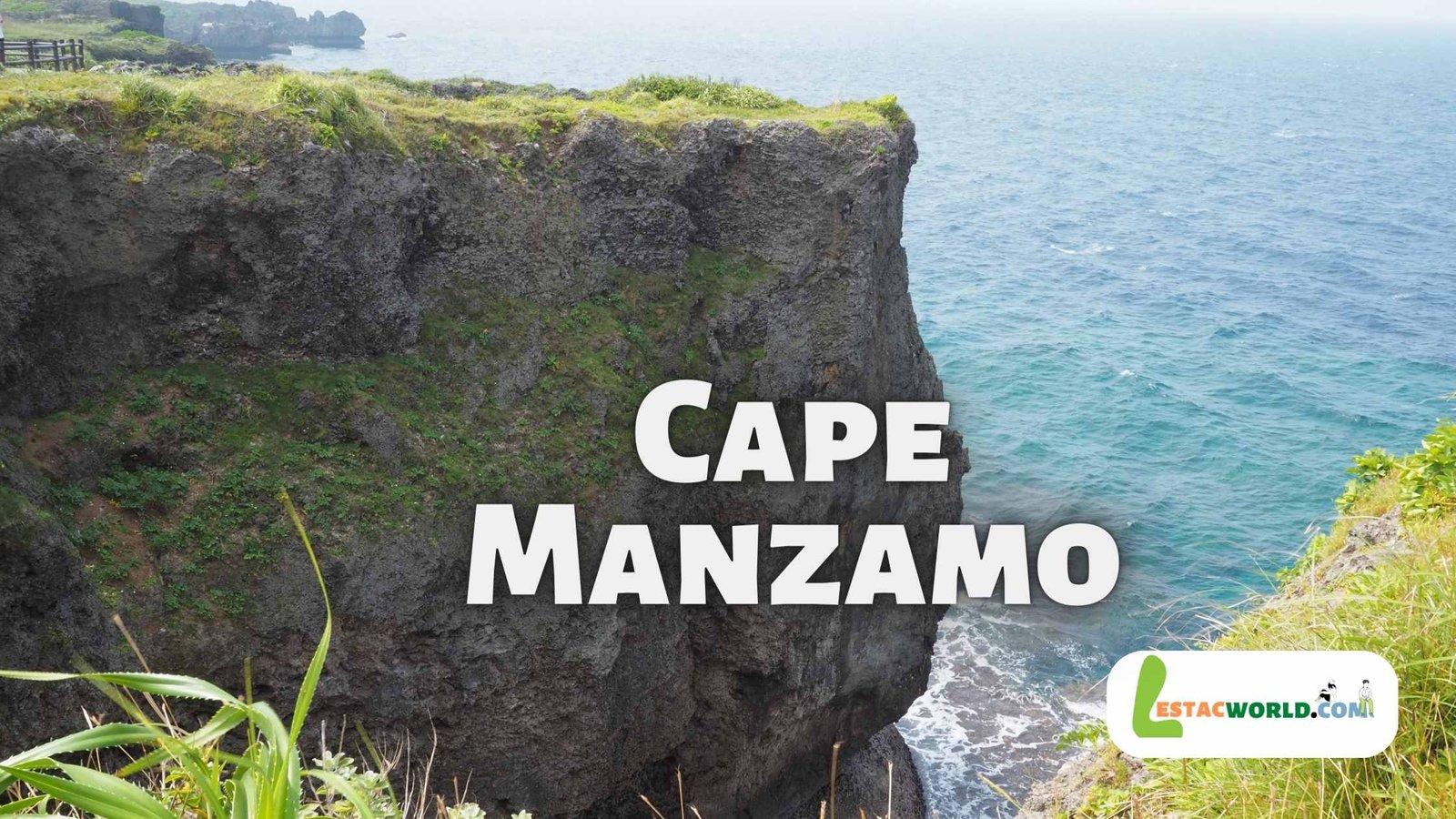About Cape Manzamo
about Cape Manzamo- In Japan’s Okinawa Prefecture, the Onna Village is home to the picturesque tourist site known as Cape Manzamo. The following information about Cape Manzamo:
Natural rock formation: Cape Manzamo is a naturally occurring rock feature that was produced by centuries of ocean erosion. An unusually shaped rock that stretches into the ocean and resembles an elephant’s trunk distinguishes the formation.
Known for its sunsets: Cape Manzamo is well-known for its breathtaking sunset views, which draw lots of tourists to the area. The hues of the sky and the water make for a beautiful backdrop for photography and soaking in the natural surroundings.
Popular tourist spot: Cape Manzamo is a well-liked Okinawa tourism spot that draws both residents and tourists from all over the world. Visitors may explore the adjacent beaches and hiking trails, and the location gives panoramic views of the ocean and the surrounding area.
Cultural relevance: For the native Okinawans, Cape Manzamo has cultural value. Many traditional Okinawan dances and rites are held here, and it is supposed to be a place of prayer and offering.
Accessibility: Cape Manzamo is easily reachable by automobile or bus, and there is a tourist parking lot close by. The property has ramps and concrete paths for wheelchair users to easily navigate.
Overall, Cape Manzamo is a lovely and culturally significant location in Okinawa that provides an insight into the local customs and culture as well as stunning natural surroundings.
History timeline of Cape Manzamo
Cape Manzamo is a natural landmark in Okinawa, Japan, that has been shaped by the ocean over thousands of years. Here is a brief history timeline of Cape Manzamo:
- Many millions of years ago: The geological formation of Okinawa began as a result of tectonic plate movements, volcanic activity, and erosion.
- 12,000 years ago: The Ryukyu Islands, which include Okinawa, were inhabited by humans for the first time.
- 14th century: Okinawa became an independent kingdom known as the Ryukyu Kingdom, which thrived as a center of trade and cultural exchange between China, Japan, and other parts of Southeast Asia.
- 19th century: Okinawa became a part of Japan after the Ryukyu Kingdom was annexed by the Japanese government.
- Early 20th century: Cape Manzamo began to attract attention as a scenic destination, and became popular among Japanese and foreign tourists.
- 1945: Okinawa became a major battleground during World War II, and many of the island’s landmarks were destroyed or damaged. However, Cape Manzamo survived largely intact.
- Post-World War II: Okinawa became a major strategic location for the U.S. military, which established several bases on the island. This led to significant social and political changes, as well as environmental impacts.
- 1972: Okinawa was returned to Japanese sovereignty, and the island’s tourism industry began to thrive.
- Present day: Cape Manzamo remains a popular tourist destination, attracting visitors from Japan and around the world. It is considered an important symbol of Okinawa’s natural beauty and cultural heritage.
How to reach Cape Manzamo
The area known as Cape Manzamo may be found in Okinawa Prefecture, Japan, specifically in the Onna Village. The following are some of the available routes to Cape Manzamo:
By Car: One of the most convenient methods to go to Cape Manzamo is by driving there in your own vehicle. About 40 kilometers to the north of Naha, which is the capital of Okinawa, is where the location may be found. To travel to Ishikawa from Naha, get on the Okinawa Expressway (which is a toll road) and take the exit for Ishikawa. After traveling approximately 20 kilometers in a northerly direction on Route 58, take a left turn onto Prefectural Route 114. This route will terminate at Cape Manzamo when it reaches its destination. Visitors can find a parking lot conveniently located nearby.
By Bus: You can also get to Cape Manzamo by taking a bus, which is another alternative. Getting to the Onna-son Yakuba Mae (Onna Village Office) bus stop requires boarding the #20 bus heading in the direction of Nago from the Naha Bus Terminal. After boarding either the #120 or #20 bus, get off at the Manzamo bus stop when you reach that point. The trip typically takes between one and two hours, depending on the amount of traffic, and the bus station is located approximately ten minutes’ walking distance from Cape Manzamo.
By Taxi: Taxis are another mode of transportation in Okinawa, however keep in mind that they can be extremely pricey. If you are going on a trip with a large party, renting a car can be the most cost-effective option.

Do's and Dont's at Cape Manzamo
Cape Manzamo is a popular tourist destination in Okinawa, Japan, that offers stunning natural scenery and cultural significance. Here are some do’s and don’ts to keep in mind when visiting Cape Manzamo:
Do’s:
- Take plenty of photos: Cape Manzamo offers panoramic views of the ocean and surrounding landscape, so don’t forget to bring a camera or smartphone to capture the stunning scenery.
- Respect the natural environment: Cape Manzamo is a natural landmark, so it’s important to respect the environment and not litter or damage the site.
- Observe local customs: Cape Manzamo has cultural significance to the local Okinawan people, so be respectful of any ceremonies or traditions that may be taking place.
- Wear comfortable shoes: The site is located on rocky terrain, so wear comfortable shoes with good grip to prevent slips or falls.
- Follow posted signs and instructions: There are posted signs and instructions throughout the site, so be sure to follow them for your safety and the safety of others.
Don’ts:
- Climb on the rocks: While the rock formations at Cape Manzamo are beautiful, it’s important not to climb on them, as this can be dangerous and cause damage to the site.
- Swim in the ocean: The waters around Cape Manzamo can be rough and dangerous, so it’s best to avoid swimming in the ocean.
- Bring pets: Pets are not allowed at Cape Manzamo, so leave them at home or in a pet-friendly accommodation.
- Touch or disturb wildlife: Cape Manzamo is home to a variety of wildlife, including crabs and fish. It’s important not to touch or disturb these creatures, as this can cause harm to them and their habitat.
- Enter prohibited areas: There may be certain areas of Cape Manzamo that are off-limits to visitors for safety reasons. Be sure to obey any signs or instructions that indicate prohibited areas.
Overall, Cape Manzamo is a beautiful and culturally significant destination that should be respected and enjoyed responsibly. By following these do’s and don’ts, visitors can have a safe and enjoyable experience while preserving the natural beauty of the site for future generations.
Highlights of Cape Manzamo
breathtaking panoramic views of the ocean and surrounding landscape. Here are some of the highlights of Cape Manzamo:
- Scenic Views: One of the most prominent features of Cape Manzamo is the picturesque views of the East China Sea. Visitors can take in the stunning scenery from a viewing platform that overlooks the ocean and the striking rock formations.
- Rock Formations: The unique rock formations at Cape Manzamo are another highlight of the site. The rocks are shaped like an elephant’s trunk, and visitors can see the natural arch formed by the rocks.
- Cultural Significance: Cape Manzamo holds cultural significance to the local Okinawan people. According to legend, a Ryukyuan goddess created the rock formations with her magic, and the site is believed to have spiritual power.
- Beautiful Sunsets: Cape Manzamo is also a great spot to watch the sunset. The site is known for its stunning views of the sun setting over the ocean, making it a popular spot for photography and romantic walks.
- Beaches: Cape Manzamo is surrounded by a number of beautiful beaches, including Manza Beach and Mission Beach. Visitors can enjoy swimming, snorkeling, and other water activities at these nearby beaches.
Overall, Cape Manzamo is a must-visit destination for nature lovers and those who appreciate stunning scenery. With its unique rock formations, cultural significance, and picturesque views, it’s a highlight of any trip to Okinawa.
Some Statistics of Cape Manzamo
Here are some statistics related to Cape Manzamo in Okinawa, Japan:
- Height: The height of the cliffs at Cape Manzamo is around 20 meters (66 feet).
- Visitors: Cape Manzamo is a popular tourist destination in Okinawa, with an estimated 1 million visitors per year.
- Location: Cape Manzamo is located in the northern part of Okinawa Island, in Onna Village.
- Size: The viewing platform at Cape Manzamo is approximately 200 meters long and 30 meters wide.
- Legend: According to local legend, a Ryukyuan goddess created the rock formations at Cape Manzamo with her magic, and the site is believed to have spiritual power.


Comment (0)